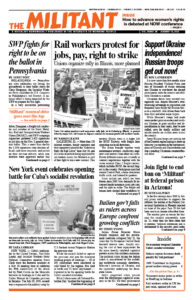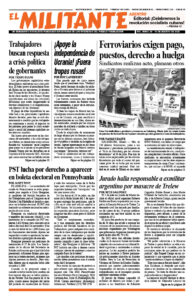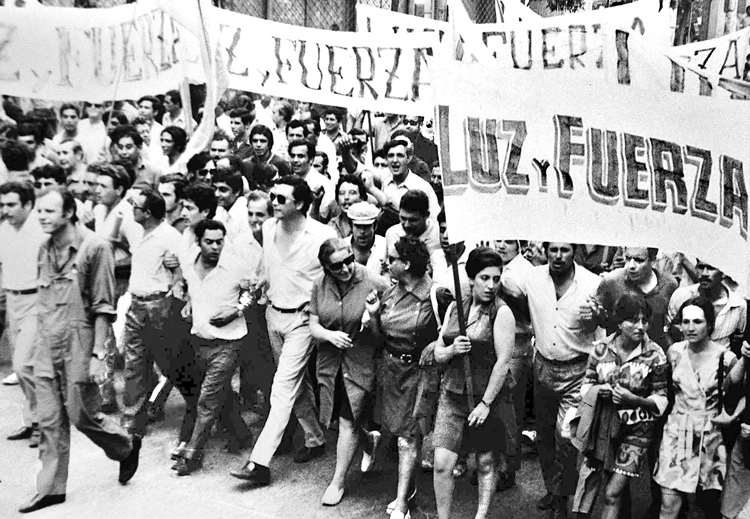This special feature is from The Leninist Strategy of Party Building: The Debate on Guerrilla Warfare in Latin America by Joseph Hansen, a leader of the Socialist Workers Party, cited in last week’s article, “Argentine military officer found guilty for 1972 Trelew massacre.” As prerevolutionary conditions and struggles developed in Latin America, Hansen helped lead the international fight to build communist parties rooted in the struggles of the working class and its allies to take power. This excerpt is from “The Lesson of Argentina” in the chapter “Argentina and Bolivia — the Balance Sheet.” Copyright © 1979 by Pathfinder Press. Reprinted by permission.
Since May 1969 the situation in Argentina has been prerevolutionary.
In that month the country was shaken by mass struggles touched off by student protests. A general strike paralyzed Rosario, Argentina’s second largest city. Major flare-ups followed in various cities, the biggest and most violent being in Córdoba, hence the name Cordobazo for this historic struggle. The two big trade union federations called a nationwide solidarity strike. This widespread upsurge in May amounted to a semi-insurrection.
The use of the term semi-insurrection rather than spontaneous rebellion or uprising is deliberate. It accurately indicates the nature of the struggle — in the streets, with masses confronting the army and police; and the target the masses had in mind — the national government. What gave it the character of a semi-insurrection was the clear political aim of the mobilizations and confrontations — to bring down the government.
That is the profound difference from the uprisings in the Black ghettos in the United States, which were spontaneous rebellions, with no specific political demands either explicit or implicit.
But even the Argentine explosions were not insurrections. For that, a revolutionary leadership applying a clear program for the conquest of power was required. None of the mobilizations of the working class in Argentina has had this feature.
We have characterized the situation in Argentina since May 1969 as “pre-revolutionary” for various reasons:
- The confusion in government circles, and the bourgeois forces generally, has grown more and more intense as they flounder about, trying to find a way out of the critical economic situation and trying to derail or break the back of the rising mass movement.
- The petty bourgeoisie is losing all confidence in the capitalist system, and significant sectors are inclining toward revolutionary or prosocialist positions.
- The working class wants a revolutionary change in the government. It has lost all confidence in the government as the various regimes have succeeded each other, without ameliorating but only worsening the crisis racking the country.
It is true that the bulk of the working class still has confidence in Peronism politically. But that is because they believe, mistakenly, that through Peronism a means can be found to change the system. In other words, they are still not aware that the Peronist party is bourgeois. This is one of the consequences of the denial of Perón’s democratic rights and his exile from the country for seventeen years.
The main obstacles blocking the workers from moving toward state power in the present situation consist of the bureaucratic leadership of the trade unions, the only existing mass organizations of the proletariat, and General Perón, the unquestioned leader of the toiling masses.
The great problem facing the Argentine revolutionary movement is how to transform the prerevolutionary situation into a revolutionary one, that is, into a direct struggle for power. …
The uprisings in Rosario and Córdoba altered the relationship of class forces. The retreat of the working class came to an end. Already significant efforts had been made to fight back, but these had been defeated. Now the working class began to take the offensive. The masses, in various stages, dealt a series of blows to successive bourgeois regimes, gaining concessions in the process.
The ruling class has oscillated between repression and concessions. This maneuvering, however, has necessarily been confined within the limits of the general crisis that has racked Argentina. The country’s semicolonial standing has not enabled the bourgeoisie to grant significant concessions except for the period immediately following World War II. The concessions that have been granted, whether of a minimal economic nature or more typically in the field of democratic rights, have only served to encourage the workers and to lead them to broaden their offensive.
The first semi-insurrections were met with a selective repression. During the whole period since 1966, the ruling class has not carried out a single massacre of the mass movement. While accurate figures are not available, it may well be that there were more casualties in the October 1968 massacre in Mexico City than in all six years of military rule in Argentina, in which a series of mass uprisings occurred. This is not because the Argentine ruling class is any less brutal or bloodthirsty than the Mexican ruling class, but because they understand the explosiveness of the class struggle and the inherent power of the proletariat in Argentina.
Bending with the pressure of the first Cordobazo, the government promised a relaxation of the repression. Once it felt that the situation was somewhat safe, the government disregarded its promise and resumed its hard line. The response from the workers was a resumption of mass actions, paralyzing strikes hitting the cities and sometimes extending to a provincial and national level. In various minor cities, general strikes were accompanied by militant street demonstrations. (It should be noted, however, that mass demonstrations in the streets with the setting up of barricades and clashes with the police have not occurred in a similar way in Buenos Aires with its population of 8,000,000.) …
Each change of government marked an attempt to avoid a direct confrontation with the masses and to divert them away from street struggles pointing in the direction of an insurrectionary general strike on a national scale.


